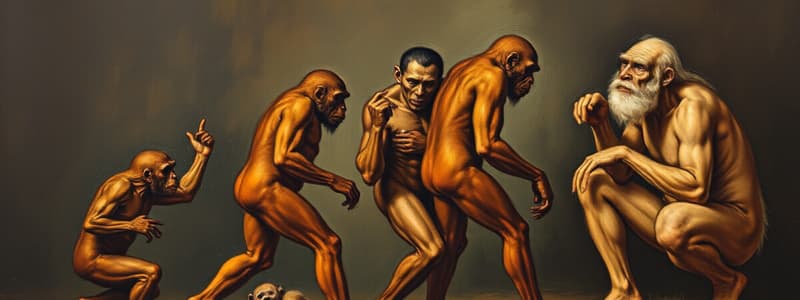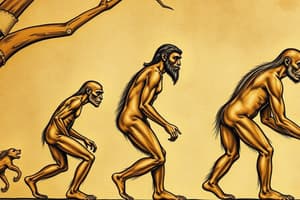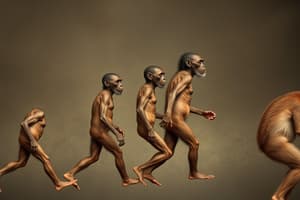Podcast
Questions and Answers
The __________ is the first known Neanderthal Man.
The __________ is the first known Neanderthal Man.
Homo sapiens neanderthalensis
Where is it believed that man's origin was?
Where is it believed that man's origin was?
- Europe
- Central Asia (correct)
- Africa
- Asia
What type of locomotion do humans have?
What type of locomotion do humans have?
- None
- Quadrupedal
- Bipedal (correct)
- Crawling
Which species is known as 'Handy Man'?
Which species is known as 'Handy Man'?
Homo erectus is also known as the __________ Man.
Homo erectus is also known as the __________ Man.
Homo sapiens neanderthalensis practiced burial of the dead.
Homo sapiens neanderthalensis practiced burial of the dead.
Which human society relies on herding and domestication of animals?
Which human society relies on herding and domestication of animals?
During which age did humans first discover the use of fire?
During which age did humans first discover the use of fire?
Which of the following is considered the first form of human society?
Which of the following is considered the first form of human society?
The Neolithic Age is characterized by unpolished stone tools.
The Neolithic Age is characterized by unpolished stone tools.
Homo sapiens are described as __________.
Homo sapiens are described as __________.
Match the following societies with their characteristics:
Match the following societies with their characteristics:
The __________ is the first known Neanderthal Man.
The __________ is the first known Neanderthal Man.
Where is it believed that man's origin was?
Where is it believed that man's origin was?
What type of locomotion do humans have?
What type of locomotion do humans have?
Which species is known as 'Handy Man'?
Which species is known as 'Handy Man'?
Homo erectus is also known as the __________ Man.
Homo erectus is also known as the __________ Man.
Homo sapiens neanderthalensis practiced burial of the dead.
Homo sapiens neanderthalensis practiced burial of the dead.
Which human society relies on herding and domestication of animals?
Which human society relies on herding and domestication of animals?
During which age did humans first discover the use of fire?
During which age did humans first discover the use of fire?
Which of the following is considered the first form of human society?
Which of the following is considered the first form of human society?
The Neolithic Age is characterized by unpolished stone tools.
The Neolithic Age is characterized by unpolished stone tools.
Match the following species with their characteristics:
Match the following species with their characteristics:
Flashcards are hidden until you start studying
Study Notes
Time of Origin of Man
- Primates evolved in the Eocene epoch of the tertiary period approximately 75-60 million years ago.
- Humans and apes share a common ancestor, evolving around 25-30 million years ago.
- The evolution of the genus Homo began around 5 million years ago.
Place of Origin of Man
- Human origins are believed to be in Asia, Africa, and Europe, with Central Asia being a likely origin point.
- Oldest fossils found in China, Java, and India support the Asian origin theory.
- Asia has the highest domestication of plants and animals, vital for early human development.
- Numerous animal migrations originated from Asia, hinting at its importance in human evolution.
- Asian culture displays significant historical depth, aiding its claim as an origin point.
- Climatic conditions in Africa, Asia, and nearby regions supported human evolutionary processes.
- Rich fossil beds in Asia and Africa provide abundant evidence of early human life.
Differences and Similarities between Man and Apes
Bipedal Locomotion
- Humans are strictly bipedal, using hindlimbs for walking while freeing forelimbs for manipulation.
- Apes primarily walk on all fours and are still adapted to arboreal life.
Upright Posture / Musculoskeletal Differences
- Humans have longer hindlimbs, a broad and flat thorax, and a lumbar spine with 4-5 vertebrae, with a lumbar curve present.
- Apes have longer forelimbs, a lumbar spine with 6-7 vertebrae, and lack a lumbar curve.
Facial Structure
- Humans possess an orthognathous face with no simian shelf, present chin, smaller canines, and a downward-facing foramen magnum.
- Apes exhibit a prognathous face with a simian shelf, absent chin, large canines, and a backward-facing foramen magnum.
Dental Characteristics
- Humans have a rounded parabolic dental arch with small incisors and no simian gap, while apes have a U-shaped arch with large, protruding canines and a simian gap.
Brain Size
- Humans have a cranial cavity averaging 1350-2000 cc, significantly larger than the 450-600 cc found in apes.
Diet
- Humans are omnivorous; apes are primarily herbivorous.
Vision and Sensory Perception
- Humans have forward-facing eyes providing stereoscopic vision, while olfactory lobes are less developed.
- Humans have less sensitivity in hearing compared to apes.
Reproductive Characteristics
- Humans have a lower breeding capacity compared to apes.
Key Species in Human Evolution
Homo habilis
- Known as "Handy Man," lived around 2.4 to 1.4 million years ago, marked by the first creation of stone tools.
Homo rudolfensis
- Characterized by a longer face and larger molars, lived about 1.9 to 1.8 million years ago.
Homo erectus
- Known as "Upright Man," existed from 1.89 to 143,000 years ago, first to use fire and develop hunting tools.
Homo heidelbergensis
- Lived 700,000 to 200,000 years ago; the first to hunt large animals regularly and build shelters.
Homo floresiensis
- "Hobbit" species, short in stature, lived from 95,000 to 17,000 years ago.
Homo sapiens
- "Wise Man," the current human species, emerged around 200,000 years ago.
Homo sapiens neanderthalensis
- Known as "Neanderthal Man," practiced burial, hunting, and gathering between 200,000 to 28,000 years ago.
Homo sapiens sapiens (Cro-Magnon)
- Anatomically modern humans lived during the last Ice Age from 40,000 to 10,000 years ago, known for cave paintings and decorated tools.
Cultural Periods of Development
- Paleolithic Age: Coincided with the first known tool construction. Developed fire use and small sculptures.
- Neolithic Age: Began around 10,000 BCE, marked by polished stone tools, permanent settlements, and reliance on domestic plants and animals.
Types of Human Societies
- Hunting and Food Gathering Societies: Earliest form, relied on foraging and simple tools.
- Horticultural Societies: Used human muscle power and simple tools for subsistence farming; marked by small settlements.
- Pastoral Societies: Relied on herding animals for food and clothing; structured around male-dominated kinship.
- Agricultural Societies: Utilized plow and irrigation systems; social classes emerged.
- Industrial Societies: Characterized by mechanical production methods; dependent on bureaucratic organization.
- Post-Industrial Societies: Emphasis on technology and knowledge industries, particularly in the computer sector.
Introduction to Human Evolution
- Primates began evolving during the Eocene epoch, approximately 75-60 million years ago.
- Humans and apes diverged from common tree-dwelling ancestors around 25-30 million years ago.
- The genus Homo emerged about 5 million years ago.
Place of Origin of Man
- Human origins are believed to lie in Asia, Africa, and Europe, with Central Asia as the most likely region.
- Oldest known fossils found in China, Java, and India support the Asian origin theory.
- Climate and rich fossil beds in Asia and Africa have been conducive to human evolution.
Differences and Similarities Between Man and Apes
-
Locomotion:
- Humans exhibit bipedalism, using hindlimbs for walking, freeing forelimbs for manipulation.
- Apes mainly walk on all fours and remain tree dwellers.
-
Posture and Musculoskeletal Features:
- Humans possess longer hindlimbs, shorter abdomens, and broader thorax; about 4-5 lumbar vertebrae.
- Apes have longer forelimbs, 6-7 lumbar vertebrae, and lack lumbar curve.
-
Facial Structure:
- Humans have a flat face (orthognathous), absence of a simian shelf, present chin, and small canines.
- Apes exhibit a protruding face (prognathous), presence of a simian shelf, absent chin, and large canines.
-
Dental Structure:
- Humans have a rounded dental arch, small incisors, and no simian gap.
- Apes have a U-shaped dental arch, projecting canines, and a simian gap between incisors and canines.
-
Brain Size:
- Human cranial cavity averages 1350-2000 cc, much larger than the 450-600 cc in apes.
-
Dietary Habits:
- Humans are omnivores, while apes primarily follow a herbivorous diet.
-
Vision and Sensory Features:
- Humans possess large, forward-directed eyes for stereoscopic vision; developed rod and cone cells in the retina.
- Olfactory lobes are less developed in humans compared to apes.
-
Social and Reproductive Factors:
- Humans have a lower breeding capacity than apes.
Key Hominid Species
-
Homo habilis:
- Known as "Handy Man"; lived 2.4 to 1.4 million years ago and attributed with the first stone tools.
-
Homo rudolfensis:
- Lived 1.9 to 1.8 million years ago; noted for larger molars and braincase compared to Homo habilis.
-
Homo erectus:
- Called "Upright Man"; existed 1.89 to 143,000 years ago, adapted to hotter climates, and was the first to produce fire and use tools.
-
Homo heidelbergensis:
- Lived 700,000 to 200,000 years ago; recognized for routine hunting, constructing shelters, and surviving in colder climates.
-
Homo florensiensis:
- Known as "Hobbit" due to small stature (~3 ft); lived 95,000 to 17,000 years ago.
-
Homo sapiens:
- Meaning "Wise Man"; all modern humans belong to this species, first appearing 200,000 years ago.
-
Homo sapiens neanderthalensis:
- Closest relative to modern humans; practiced burial, hunting, and clothing making from animal skins, existing 200,000 to 28,000 years ago.
-
Homo sapiens sapiens:
- Subspecies known as Cro-Magnon, characterized by anatomical modernity; lived from 40,000 to 10,000 years ago, recognized for cave paintings and tool crafting.
Cultural Periods in Human History
-
Paleolithic Age:
- Spanning approximately 2.5 million years ago; associated with the use of unpolished stone tools, discovery of fire, and early art forms.
-
Neolithic Age:
- Began around 10,000 BCE; marked by the emergence of polished stone tools, permanent settlements, domestication of plants and animals, and the rise of crafts such as pottery.
Types of Human Societies
-
Hunting and Food Gathering Societies:
- Earliest human societies; relied on foraging, simple tools, and nomadic living.
-
Horticultural Societies:
- Used human muscle power and hand tools; featured small, politically organized settlements.
-
Pastoral Societies:
- Depended on herding and domestication of animals; organized around male-dominated kinship.
-
Agricultural Societies:
- Employed plowing and irrigation; saw the establishment of taxation and entrenched social classes.
-
Industrial Societies:
- Characterized by mechanical production; organized exchange systems emerged.
-
Post-Industrial Societies:
- Focus on technological progress with a strong emphasis on information and computer industries.
Revision Questions
- Fill in the blanks questions about key concepts and species.
- True or False statements for comprehension checks on various facts.
- Matching questions to associate types of societies with their characteristics.
Studying That Suits You
Use AI to generate personalized quizzes and flashcards to suit your learning preferences.




